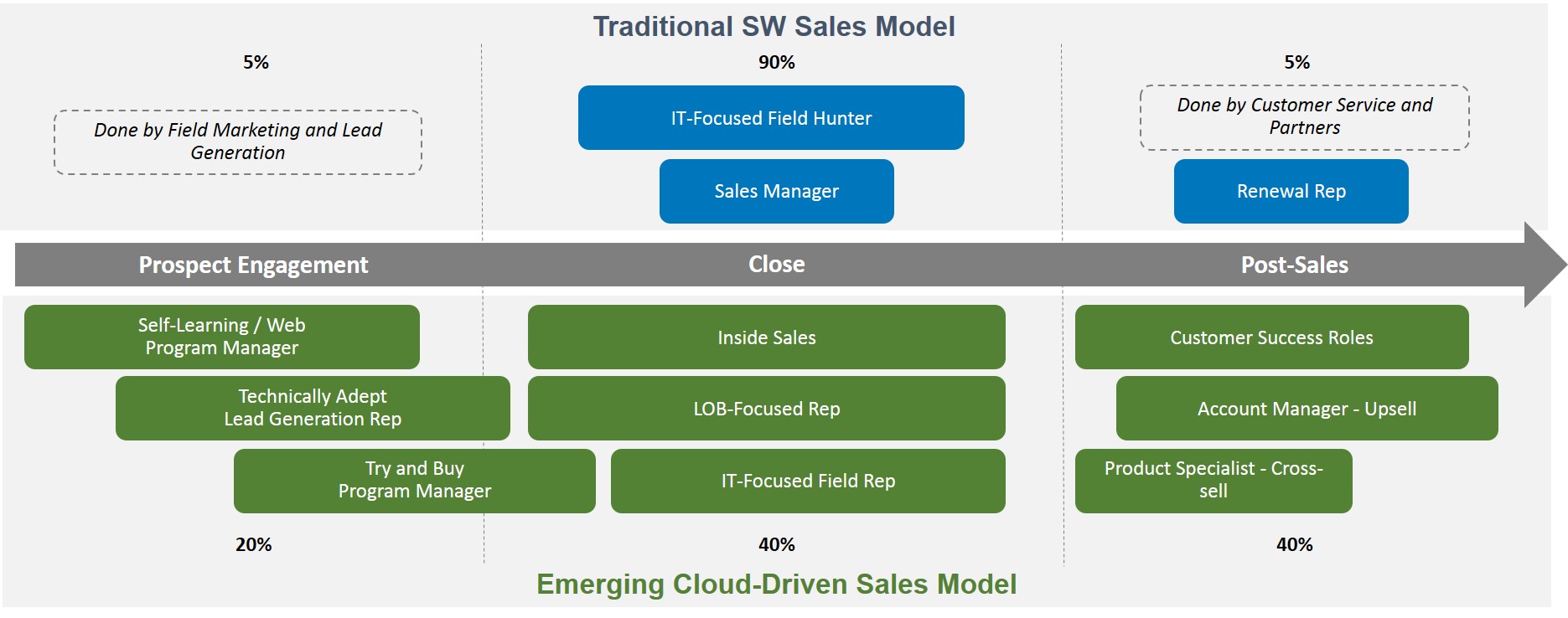Expanding Customer Lifetime Value With the Right Sales Coverage

Expanding the Customer Lifetime Value (CLV) is a financial imperative for technology companies who seek to establish a recurring revenue business model. Expanding CLV ensures recoupment of Customer Acquisition Cost (CAC) and drives long term profitability.
Winning companies deploy the right customer-facing roles in the post-sale to drive CLV expansion. Importantly, these roles fundamentally differ from traditional high tech account executives.
As the software industry migrates to XaaS, these post-sales roles have become increasingly vital and represent a growing percentage of the overall sales investment. Consider the figure below:
What Is Customer Lifecycle Management?
Customer Lifecycle Management is a strategy and ideology your business can use to maintain mutually beneficial relationships with customers. Your business and your customers have a lot to gain from working together—the products or services you provide empower your customers to perform at their best, while customer revenue keeps your business going and growing.
Just as bringing in new customers requires a time and capital investment from your business, those buyers would find it taxing to have to identify new sources for the products or services they need. Sticking together is in everyone’s best interest, and there is a lot your company can do to ensure the relationship lasts.
Customer Lifecycle Management involves extensive research and analysis into your customers’ habits before and after a purchase. Your business can track customers at every stage of the customer lifecycle, then use those findings to build plans that reaffirm the relationship at every juncture.
Attentive Customer Lifecycle Management can produce many benefits for your company as long as you prioritize customer relationships in every aspect of your business.
Customer Lifecycle Stages
There are several phases within the Customer Lifecycle that every single customer goes through. Within each of these phases, there are unique flashpoints where a poor experience could result in churn. Here are four of the most common flashpoints:
1. Onboarding
Once the sales contract has been signed, customers go through an onboarding phase which introduces them to the service, best practices to drive adoption and how to get support. Often times, this process will be led by the Customer Success function with support from an implementation team.
It is the job of Customer Success to ensure that all customers make it through this phase, learning what they need to know and emerging with the confidence to move on to the deployment phase. Failure to truly understand how to best deploy the solution often results in either early account churn or excessive support resources required to correct a poor onboarding experience.
2. Deployment
Following the onboarding process, customers go through their first deployment. The system is configured to their specifications, and workflows are customized to support the new solution. Implementation teams will often play a lead role in this phase, but it is up to the Customer Success function to work with the customer to define and quantify what a successful outcome looks like, addressing such questions as:
- What would make this deployment a resounding success?
- What are possible roadblocks that could arise that would take the customer off course?
- How can Customer Success ensure that the experience is a good one and that the customer is able to realize the benefits that they purchased?
3. Adoption
Once the solution has been configured and has been launched to the target audience, Customer Success helps the customer gain traction and drive usage of the solution. Customer Success should come to the table with strategies and tactics to help drive user adoption as they seek to incorporate the solution into the Standard Operating Procedures of the business.
The goal of Customer Success is to have users ask themselves, “How did I ever do this without your solution?” Regardless of how great the solution is, without strong adoption it would be hard for anybody to rationalize continuing to subscribe if it is never used.
4. Growth
If there has been strong adoption of the core products, customers will often expand their usage to other business units or look at other products within the portfolio. This is where the Customer Lifecycle begins again. By expanding their usage, customer expectations continue to rise, but so does their investment in your company. The role of Customer Success is to ensure that the customer continues to see value in their relationship with you.
Customer Lifecycle Management Roles
The way you structure your sales department influences your Customer Lifecycle Management’s success. Alexander Group research has revealed that struggling companies allocate roughly 90% of their sales budgets to one single account executive or account manager role, with only 5% of the sales budget going to post-sale coverage. Conversely, businesses undergoing successful sales model reorientation allocate as much as 40% of their sales budgets to adoption and growth. Allocating funds to the following roles will improve your company’s approach to Customer Lifecycle Management.
A Distinct Account Manager Role
While not true in all instances, there is a trend toward a bifurcated coverage model between hunters and farmers. The pure PM/farmer role usually occurs at the upper levels of the segmentation pyramid (enterprise and large accounts) and is responsible for driving quarter/quarter or year/year account growth.
Customer Success Roles
These roles come in multiple flavors (AGI has encountered many different variations of this role in the marketplace) and are responsible for ensuring the customer is receiving maximum value from the solutions the company has purchased. Variations in the role result from different areas of focus, including such aspects as providing customer service, training users, identifying ways to optimize the implementation, and identifying opportunities for value optimization through upsell or cross-sell. In recurring revenue models, the customer adoption and usage of the offering is paramount to driving CLV. Otherwise, customers will either 1) not renew their subscriptions or 2) not increase their consumption. Both have financial impact.
Revised Role of Product Specialist Cross-Sell Roles in the Post-Sales Environment.
These roles often existed in traditional software sales but typically focused on pre-sales activity, not post-sale work (i.e., once a customer has been up and running on an initial implementation). Today, product specialists in the XaaS model leverage awareness of the existing implementation and usage patterns (use cases) to drive sales of other features and products to either the same buyers or other buying groups within the customer. Product specialists in this environment either closely coordinate with the rest of the “post-sale” coverage team or find ways to access the customer usage information.
How to Increase Customer Lifetime Value
Customer Lifetime Value (CLV) is a customer’s total worth to your business over the entirety of the relationship. There are a few Customer Lifecycle Management tactics that your business can employ to increase CLV, including:
Enhance Digital Capabilities
Sales motion complexity varies from company to company but almost any organization can leverage digital in some way. Options vary from complex (100% self-serve sales models to capture the long tail) to more straightforward (chat specialists to qualify and progress opportunities). Schedule a digital briefing to capture Alexander Group’s most recent research.
Double Down on Expansion Sales
Acquiring new customers is expensive and some organizations will always rely on high-priced field sellers to close net-new business. However, that doesn’t mean organizations are handcuffed to improve the CLV numerator. Leverage Customer Success resources to identify upsell or cross-sell opportunities within the install base. Improve product telemetry to monitor usage and at-risk customers. Specialize sales coverage across the LAER spectrum.
Solidify Relationships
Now is not the time for aggressive sales pitches. Empathize with customers and provide assets/insights they can use to manage their business through the current COVID-19 turbulence. Providing a helping hand today will lead to deals in Q3 and Q4 when the pandemic subsides.
Plug Churn Leaks
Retention is a critical factor in the calculation; a single percentage point change will materially impact CLV. Alexander Group suggests the following actions to improve retention: ensure renewal reps and Customer Success managers have well-defined 90-, 60- and 30-day renewal playbooks. Continuously monitor customer health scores. Lastly, adjust the underlying health score methodology to improve its retention correlation.
Customer Lifecycle Management in Practice
Alexander Group has prescribed Customer Lifecycle Management practices to help businesses in numerous industries reduce churn and boost revenue.
One Fortune 500 high-tech company consulted with Alexander Group while transitioning from a hardware and equipment provider to an as-a-Service (aaS) solution provider. Their new offerings would include hardware, software and services. The company needed to gain the capability to provide value and retain engagement across the entire customer lifecycle.
The company’s previous exclusive role as an equipment provider meant that its leaders had little insight regarding customer behavior past the initial sale. Alexander Group built an arsenal of customer information by interviewing customers across the market.
The now-aaS company uses the information Alexander Group gathered to better understand the buyer journey and develop coverage models accordingly. Implementing this model empowered the company to expand its offerings and boost renewal rates.
Partner With Alexander Group
The researchers and implementation specialists at Alexander Group are ready to help your business uncover ways to provide value and ensure customer engagement across the entire lifecycle. Please contact us online to discuss the ways our services can benefit your company.
